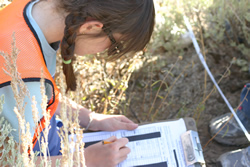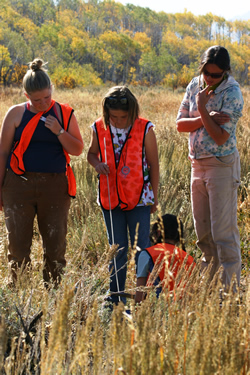
National Fire Plan Success Story
Fifth Grade Students Conduct Fire Effects Research for Park
Grand Teton National Park, Wyoming
National Fire Plan - Accountability
2008

A Teton County fifth-grade student records the number and size of bitterbrush and sagebrush along a transect in a 2001 prescribed fire site.

Teton Science Schools graduate student (from left) Sara Fuller, and fifth-grader Cassidy Weaver measure the height of a sagebrush while Alta Elementary School teacher Jade Pittel and another student observe.
In September 2008, fifth-graders from all Teton County, Wyoming schools participated in a three-day place-based program with Teton Science Schools (TSS) with an emphasis on fire ecology and fire effects research. Since 1971, all fifth grade students from Teton County have visited the TSS Kelly campus for a three-day program each fall that includes a field research day. This year, TSS partnered with Grand Teton National Park to incorporate fire effects research into their lesson plan. As a result 200 fifth-grade students conducted vegetation-monitoring research in burned and unburned sagebrush.
The research plots took place in the 2001 TSS prescribed fire that interagency fire crews conducted for fuels reduction. They collected data that will be used for Grand Teton National Park’s fire effects program.
“The fifth-grade students’ research was authentic and useful for Grand Teton National Park,” said Josh Kleyman, TSS lead graduate faculty. “Students were truly inspired to know that their data collection and academic work had real world implications. Moreover, the teachers were excited about this new and applied opportunity.”
All students measured sagebrush and bitterbrush along transects in burned and unburned areas, but each group had a different twist to their research. For example, one group compared soil moisture and temperature in each site, one counted scat from different species, and another collected insects. Each group made comparison graphs and presented their findings to the rest of the students.
“TSS students are contributing field data that is valuable to the Park’s fire management program,” said fire ecologist Diane Abendroth. “This partnership gives us an opportunity to explore new and important questions about local fire ecology.”
TSS is returning to the Teton County fifth-grade classrooms this spring to follow up with the students. They will create graphs and analyze the data they gathered in September, while incorporating math and science standards emphasized by the school district.
Contact: Traci Weaver, Fire Communication and Education Specialist, (307) 739-3692.